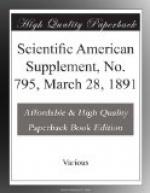I have not succeeded in getting the “Edison” current incandescent lamps to change in direction at even the highest degree of exhaustion which my pump will produce. The subject requires further investigation, and like other residual phenomena these discrepancies promise a rich harvest of future discoveries to the experimental philosopher, just as the waste products of the chemist have often proved the source of new and valuable bodies.
PROPERTIES OF RADIANT MATTER.
One of the most characteristic attributes of radiant matter—whence its name—is that it moves in approximately straight lines and in a direction almost normal to the surface of the electrode. If we keep the induction current passing continuously through a vacuum tube in the same direction, we can imagine two ways in which the action proceeds: either the supply of gaseous molecules at the surface of the negative pole must run short and the phenomena come to an end, or the molecules must find some means of getting back. I will show you an experiment which reveals the molecules in the very act of returning. Here is a tube (Fig. 14) exhausted to a pressure of 0.001 millimeter or 1.3 M. In the middle of the tube is a thin glass diaphragm, C, pierced with two holes, D and E. At one part of the tube a concave pole, A’, is focused on the upper hole, D, in the diaphragm. Behind the upper hole and in front of the lower one are movable vanes, F and G, capable of rotation by the slightest current of gas through the holes.
[Illustration: FIG. 14—PRESSURE = 0.001 MM. = 1.3 M.]
On passing the current with the concave pole negative, the small veins rotate in such a manner as to prove that at this high exhaustion a stream of molecules issues from the lower hole in the diaphragm, while at the same time a stream of freshly charged molecules is forced by the negative pole through the upper hole. The experiment speaks for itself, showing as forcibly as an experiment can show that so far the theory is right.
This view of the ultra-gaseous state of matter is advanced merely as a working hypothesis, which, in the present state of our knowledge, may be regarded as a necessary help to be retained only so long as it proves useful. In experimental research early hypotheses have necessarily to be modified, or adjusted, or perhaps entirely abandoned, in deference to more accurate observations. Dumas said, truly, that hypotheses were like crutches, which we throw away when we are able to walk without them.




